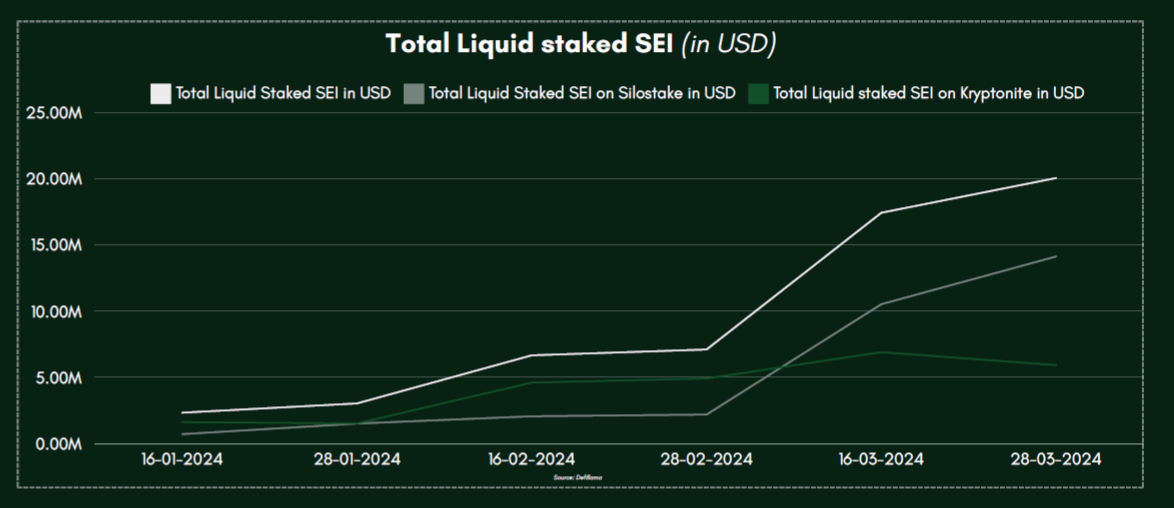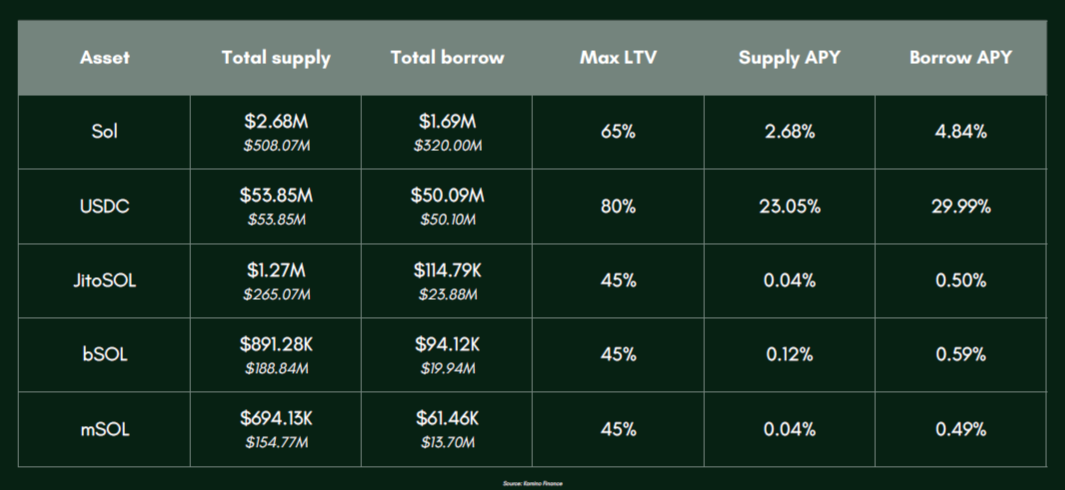Introduction
Sei is a Layer 1 blockchain designed for trading. Sei uses the Twin turbo mechanism with Proof of stack consensus. Sei also has multiple degrees of parallelization to reduce latency and maximise throughput.
Sei, similar to other Proof of Stake (POS) blockchains, requires network participants to stake their tokens to validate a block. This consensus mechanism ensures the network's integrity and functionality while rewarding validators and delegators with staking rewards.
While staking is necessary to make a network secure & decentralised, it reduces liquidity from the network. What’s the answer to this problem? Liquid Staking.
Liquid staking was introduced by Lido Finance in 2020, starting with the Ethereum blockchain and then expanding to other PoS chains. On Ethereum, Liquid Staking is the biggest category by TVL.
With this report, we will look at the Liquid Staking ecosystem on the Sei blockchain. We will analyse Liquid staking protocols currently active on Sei and how liquid staking is performing on Sei. We will also compare liquid staking on Sei with liquid staking on other chains and will try to draw conclusions about the future of liquid staking on Sei.
How staking works on Sei
Here is the step-by-step process on how staking works on Sei:
Users can delegate their SEI tokens to validators of their choice, giving validation rights through staking.
Validators, running full nodes, validate transactions, and propose new blocks. The probability of being chosen to propose the next block increases with the amount of SEI staked to them.
Validators receive rewards in SEI tokens for proposing new blocks and validating others' proposed blocks. These rewards are generated from transaction fees and newly minted SEI tokens.
Rewards earned by validators are distributed proportionally among their delegators, adjusted for each delegator's stake. Validators may deduct a commission percentage before distributing rewards.
Delegators can earn staking rewards without running a validator node themselves, with current rewards averaging around 4-5% APR on Sei.
Staked SEI tokens are subject to a lock-in period. On Sei, the unbounding period is 21 days.
Validators must maintain a minimum amount of self-staked SEI. Poor performance or misconduct may result in stake-slashing penalties.
Key points about SEI staking:
-> No minimum amount is required to stake SEI.
-> Rewards are distributed with every block, occurring approximately every 0.35 seconds.
-> The current annual reward rate for staking SEI is estimated at 4-5%.
Staked SEI cannot be traded or transferred until unstaked and after the 21-day unbounding period has been completed.
Need & Benefits of Liquid Staking on Sei
Liquid staking involves staking tokens on the Sei network and receiving a liquid staking token in return, which represents the staked assets and can be freely traded or used in DeFi applications.
There are several benefits of Staking tokens by Liquid staking rather than by native staking. Here are those:
Increased Liquidity: Liquid staking allows users to access the liquidity of their staked tokens while tokens are staked & earning staking rewards. Users can lend, borrow, trade, or use liquid staking tokens in any possible DeFi application.
No 21-day unbound period: Users can swap liquid staking tokens with native tokens using DEX/AMMs which means the user does not have to wait for 21 days for their tokens.
Higher Rewards: By staking using liquid staking than native staking users can earn higher rewards. This is because liquid staking tokens can be used to generate additional yield using Defi applications like Providing Liquidity, and borrowing and trading on top of the base staking yield.
Liquid Staking Protocols on Sei
Liquid Staking on Sei is a fairly new ecosystem. Only 3 protocols offer liquid staking on Sei as of now – SiloStake, Kryptonite, and Eris. Out of these 3, Eris is a Multi Chain liquid staking provider, with active services on more than 11 chains & majorly focusing on Terra, Kujira & Osmosis. So we won’t talk about Eris.
For the remaining part of this section, we will discuss the two leading liquid staking protocols on Sei:
SiloStake
Kryptonite

What can Sei learn from Ethereum & Solana staking
Liquid Staking is a new concept on Sei but not in web3. Lido introduced Liquid staking on Ethereum in 2020. Since then Liquid staking has emerged as the biggest Defi category on Ethereum according to TVL. Currently, more than 34% of total ETH staked on Ethereum is via liquid staking.

Similarly, the biggest “alternative L1” Solana has more than 5% of its native token SOL staked by liquid staking.
Here is the comparison table for the liquid staking ecosystem on Sei and other new L1s.

Liquid staking on Sei is growing rapidly. For context, Volo, the first liquid staking protocol on Sui began taking deposits in Oct 2023, whereas the other liquid staking protocols on Sei (SiloStake and Kryptonite) enabled staking features only in Jan 2024. Despite liquid staking being a new concept on Sei, 0.4% of staked supply of SEI is staked via liquid stakers (like SiloStake and Kryptonite). This is similar to Sei’s non-EVM “Alt L1” competitor Sui.

As shown in the above image, liquid staking on Sei grew by 750% in less than 3 months, which is massive! Despite this growth, the total Sei staked by liquid staking remains at < 1%. In the next 1-2 years this participation can easily pick up to 3-4%. This is around 10x growth from here for the Sei sub-sector.
This growth, however, is not straight forward. Looking at the growth of liquid staking on Ethereum, here are some important factors that will influence the growth of liquid staking on Sei.
How rewards on staked Sei will go.
Currently, the native SEI staking rate is 4.45%. Kryptonite Offers 4.45% APY and 50% APR on staking of native token $SEILOR. Silostake on the other hand provides 5% APR on SEI staking.
More than 60% of SEI tokens are staked which shows confidence in token holders for SEI token. But to attract more stakers, the yield on SEI staking should go up.
For context: Currently APTOS Provides 7% APR on staked tokens and Avalanche provides ~8.5% APR on staked tokens.
Out of a total supply of 10 billion SEI, 51% of the SEI tokens are allocated to ecosystem reserves, which are used for staking rewards, ecosystem initiatives & Airdrops. Out of this 51%, around 65% SEI tokens are yet to be unlocked.
Ecosystem reserve will be fully unlocked till August, 2030. Which means till Aug, 2030 staking rewards will be addition of transaction fees as well as new tokens introduced with every block, once this inflation rate goes down , the only way for Sei to reward stakers enough will be a high enough transaction volume.
How iSEI & stSEI get use-cases in Defi.
Another question is – what can someone do with liquid staking tokens? For example, stETH, the liquid staking token for Ethereum issued by Lido can be provided as liquidity on Curve pools to additionally earn ~2.5% APY.
Similar use-cases are there for iSEI and stSEI. iSEI & stSEI can be provided as liquidity on Astroport pools to earn 0.01% & 0.06% APR. but this amount is not significant. But liquid staking on Sei is still really early, and we will see significant developments and more use-cases emerging for SEI LST tokens.
The core idea behind LST tokens is to bring liquidity on-chain. As stated previously, currently more than 60%of SEI tokens in circulation are staked. These tokens can not be used for further DeFi activity, which is a huge loss in liquidity on-chain.
Liquid staking tokens (LST) solves this issue.
For example, on the leading money market of Solana (Kamino) liquid staking tokens dominated in both TVL as well as trading volume.


This is a live example of how liquid staking tokens bring huge liquidity to the ecosystem. As liquid staking protocols on Sei (namely Silostake and Kryptonite) grow, so will DeFi activity on Sei due to higher liquidity.

One more similar example for Aave. As shown in the above image WstETH has been the biggest collateralized asset on Aave for more than 6 months now.
Some users deposit wstETH on Aave and then borrow ETH against it as collateral. They can then stake that borrowed ETH via Lido to get more wstETH, and re-deposit that on Aave to borrow even more. This recursive lending allows them to leverage up their staked ETH position to amplify rewards. Similar strategies can emerge out of Sei liquid staking & defi.
Other aspect can be people borrowing low cap coins against wstETH for short term market gains & airdrops strategies.
Future Perspective
As said previously, Sei liquid staking is still very new. Hence, jumping to growth-oriented conclusions will be hasty.
Rather than speculate, let’s look at this from the perspective of how liquid staking evolved on other PoS blockchains.

The growth of liquid staking on Ethereum was rapid and massive. The primary catalyst for this was the inability to withdraw staked ETH until the Shanghai upgrade. This created a demand for liquidity through liquid staking derivatives. Whereas, for other L1 blockchains like Solana & Avalanche, withdrawals were enabled from the very start. So there was less pent-up demand for liquid staking. However, liquid staking is still expanding on these alternate L1s through protocols like Marinade and Benqi, just at a slower pace than the explosive growth seen on Ethereum.
Liquid staking on Sei will probably follow a similar growth path as Solana and Avalanche. Also, it’s important to note that the Defi ecosystem on Sei itself is pretty nascent. But with recent growth in the overall Sei ecosystem, it’s safe to say that liquid staking on Sei can touch $60-80m in TVL in the next 3-6 months if similar trends continue for Sei growth.
One thing that the Sei community should avoid is allowing one liquid staking protocol to establish a monopoly (like Lido Finance). This increases centralisation risk. Chains can do this by promoting a diverse & decentralised set of validators is important for the security of the underlying network.
PYOR Is An Interpretation Layer For Digital Assets. Go beyond the surface level with our data product XRAY. Check out XRAY → pyor.xyz.

